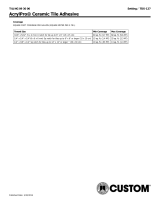
installation of large format ceramic tile recommends that the substrate have no more than a 1/8" in 10'
variance; with no more than 1/16" variation in 24". The preparation of a substrate is important in any
installation, but with large format tile a flat surface is crucial. The depressions found in all concrete slabs or
wood sub-floors are a landscape of mountains and valleys when setting large format tiles.
A substrate that exceeds the ANSI standards must be corrected with an appropriate patching or
self-leveling underlayment such as Custom’s LevelLite
®
Self-Leveling Underlayment or must be ground to
the correct tolerance. A flat substrate ensures a high quality, fast installation.
Also note that floor deflection is also an important consideration — check your floor span and tile weight to
local building codes. Control joints must be incorporated into these large expanses of ceramic and natural
stone tile. Expansion joints should not be covered but should be continued through to the finished surface,
and cracked or suspended substrates should be covered with an appropriate crack isolation membrane,
such as Custom’s Crack Buster
®
Pro.
Question: How do I select the appropriate mortar for installing large format tile?
Answer: A: TCNA recommends the use of mortars meeting ANSI A118.4, A118.15 (improved performance cement
mortar) and A118.11 (for plywood surfaces) for these installations.
CUSTOM offers a complete line of thin-set mortars that can be used in medium-bed applications to meet
the needs of the large format tile in every situation. The installer can choose the right mortar for the
project, whether the project demands the highest performance or needs to be done quickly.
PROLITE
®
LARGE FORMAT TILE & STONE MORTAR offers high flexibility and bond strength in a lightweight
formula with excellent handling characteristics for a wide variety of floor and wall tile installations. Excellent
for setting large format tile or stone, ProLite will not sag or slip on walls and offers non-slump performance
for floor installations and is suited for thin-set or medium-bed application up to 3/4" thick on floors. ProLite
exceeds the requirements of ANSI A118.4, A118.15 and A118.11. ProLite is also available in a rapid setting
version for time critical applications – grout in three hours.
COMPLETE CONTACT-LFT RAPID SETTING MORTAR is a new, premium mortar that offers full mortar transfer
to the back of large format tile with minimal installer’s effort, eliminating the need for back-buttering or
extensive beating-in techniques saving time and labor for most installations. It is more fluid than traditional
thin-set mortars yet holds its ridges and supports the deeper notch trowel sizes for large format tiles.
Formulated with Controlled Cure Technology™, it cures rapidly and develops high early strength for quicker
installations, grouting can occur in as little as three hours, allowing the surface to be open for heavy
commercialtrafc24hoursaftergrouting.CompleteContact-LFTRSexceedstherequirementsofANSI
A118.4, A118.15 and A118.11 without an additive.
LARGE FORMAT TILE-LFT MORTAR is a new, non-slip, non-sag and non-slump polymer modified medium-
bed mortar specifically designed for large-format tile and stone for interior and exterior floor, wall and
countertopinstallations.CUSTOM’sLARGEFORMATTILE-LFTMortarhasexcellenthandlingfeaturesand
exceeds the requirements of ANSI A118.4 and A118.11.
Question: What size trowel should I use to set large tile?
Answer: Larger trowels, such as a ½" x ½" x ½" square notch, will save you time and labor costs. The cost difference
in mortar coverage is less than the time and effort wasted using a “smaller” trowel such a 3/8" notch trowel.
This is true, since back-buttered large format tile requires more mortar to achieve the minimum coverage.
With large format tile, it can be challenging to obtain full mortar transfer from the substrate to the back of
the tile without leaving voids. Using the correct notched trowel provides a proper setting bed and reduces
the amount of time spent on pulling and resetting tile due to lack of coverage.
To increase mortar coverage required for large format tiles, Custom Building Products has developed a
new SUPERIORBILT
®
Premium Notch Trowel specifically designed for large format tile and stone
installations. The trowel is available in three notch sizes to accommodate variations between the tile and
substrate.TheuseoftheSUPERIORBILTPremiumNotchTrowelwiththeappropriatemedium-bedmortar
willhelptoensurethatthesetilesmeeta95%orbettercoveragerate.Unlikeordinarynotchtrowels,
CUSTOM’s patented notch pattern provides more contact with less pressure. These patterns give a more
predictable flow of mortar reducing the size and amount of air pockets under the tile.
Question: How do I install large format tile on walls? Will they slip?
Answer: Custom’s mortars have been designed for slip resistance. Both ProLite Large Format Tile & Stone Mortar
and Large Format Tile-LFT Mortar are formulated with non-sag and non-slip characteristics to prevent tiles
from slipping on vertical applications.
Question: Do I need anything special for suspended floors?
Answer: NTCA and TCNA highly recommend the use of crack isolation membranes when installing large format tile
on suspended floors; particularly in high traffic areas.











